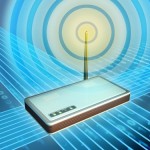
A new flavor of Wi-Fi, with longer range and better wall-piercing power, could show up in wireless gadgets a year from now if the Federal Communications Commission works out the last details of new spectrum rules that long have been in the making.
Nearly two years ago, the FCC voted to open up the airwaves between broadcast TV channels—so-called “white spaces”—for wireless broadband connections that would work like Wi-Fi on steroids.
But wrangling over key technical details, including concerns about interference with TV signals and wireless microphones, has prevented exploitation of these spaces.
On Sept. 23, the FCC plans to vote on rules meant to resolve those issues. FCC Chairman Julius Genachowski predicts electronics makers will jump at this “super Wi-Fi” technology, as the agency calls it, and make it just as popular as conventional Wi-Fi.
“We’re hoping history will repeat itself,” Genachowski said. “White spaces are a big deal for consumers and for investment and innovation.”
The commission’s plan would make white spaces available for free, without specific permission, just as it already does for Wi-Fi and Bluetooth.
Last year’s transition from analog to digital television broadcasting freed up enough spectrum to make this possible, but the plan faced serious opposition from TV broadcasters worried that their signals could be disrupted. Wireless microphone manufacturers and users—including churches, schools, theaters, karaoke bars, and all types of performers—also raised concerns about interference.
To address these issues, the FCC has been working with broadcasters and white-spaces proponents to map TV channels across the country. The current FCC plan would require installers to configure white-spaces devices to use a frequency that’s vacant in their area—a white space.
Alternatively, the devices themselves could figure out their location using such technologies as GPS; a database would then help the devices figure out the right frequencies for their area.
In addition, the agency hopes to set aside at least two channels for minor users of wireless microphones. And it plans to put big wireless microphone users, such as Broadway theaters and sports leagues, in the database, so devices would know to avoid their airwaves.
The upcoming FCC vote is a welcome development for some of the country’s biggest technology companies, including Google Inc., Microsoft Corp., and Dell Inc. The tech industry hopes that white-spaces networks will create a multibillion market for advanced wireless devices, including laptops, set-top boxes, and smart phones.
“We’ve all been chomping at the bit in the tech community … to get going with white spaces,” said Richard Whitt, Google’s Washington-based counsel for telecommunications and media. “These are highly valuable, open, unused airwaves.”
If all goes according to plan, Liam Quinn, chief technology officer for client business at Dell, expects to see “proof of concept” products at the Consumer Electronics Show in January, followed by early products in about a year and mass production a year after that.
White spaces are particularly well suited to providing broadband, tech companies say, because they can penetrate walls, have plenty of network capacity, and are able to cover large areas. According to Quinn, the signals can travel several miles and deliver internet speeds ranging from 15 to 20 megabits per second—as fast as a cable modem.
Technology companies envision all sorts of uses for white spaces: providing emergency services in disaster zones and creating home wireless networks that can send video between television sets and computers, to name just a few possibilities.
Assuming the challenges of interference with wireless microphones can be worked out, the technology also could prove useful for schools to deliver wireless connections across their buildings or campuses that have enough bandwidth to support video and other robust applications.
And it could be particularly useful for delivering wireless connectivity within older buildings where concrete walls and other barriers impede the strength of wireless signals.
Wilmington, N.C., one of a handful of U.S. communities testing the technology, is using white-spaces connections to send live video feeds from traffic and surveillance cameras.
The city’s network also gathers real-time data from a sensor in a remote part of the local watershed to monitor water quality and levels. Previously, Wilmington Mayor Bill Saffo said, the city had to send a worker out in a boat once a month to collect the data, as the city’s Wi-Fi network could not reach the sensor.
“There are a million and one possibilities for this spectrum,” Saffo said.
Neeraj Srivastava, a vice president at a Florida company called Spectrum Bridge Inc., noted that white-spaces networks could be used to bring high-speed internet access to remote corners of the country where the phone and cable companies don’t offer landline broadband. That’s a high priority for the FCC.
Indeed, Spectrum Bridge, which helped build the Wilmington network, also helped build a test system in rural Claudeville, Va., a community that had only dial-up internet and costly satellite-based broadband service before.
For now, it remains unclear whether the FCC’s plan for dealing with interference will go far enough for the broadcast industry, which wants the FCC to require that white-spaces devices include spectrum-sensing technology that can detect when airwaves already are being used. The FCC left that requirement out amid opposition from the tech industry.
“This is still a work in progress,” said David Donovan, head of the Association for Maximum Service Television, which handles technical issues facing broadcasters. “But we’re trying to make it work.”
- Research: Social media has negative impact on academic performance - April 2, 2020
- Number 1: Social media has negative impact on academic performance - December 31, 2014
- 6 reasons campus networks must change - September 30, 2014

